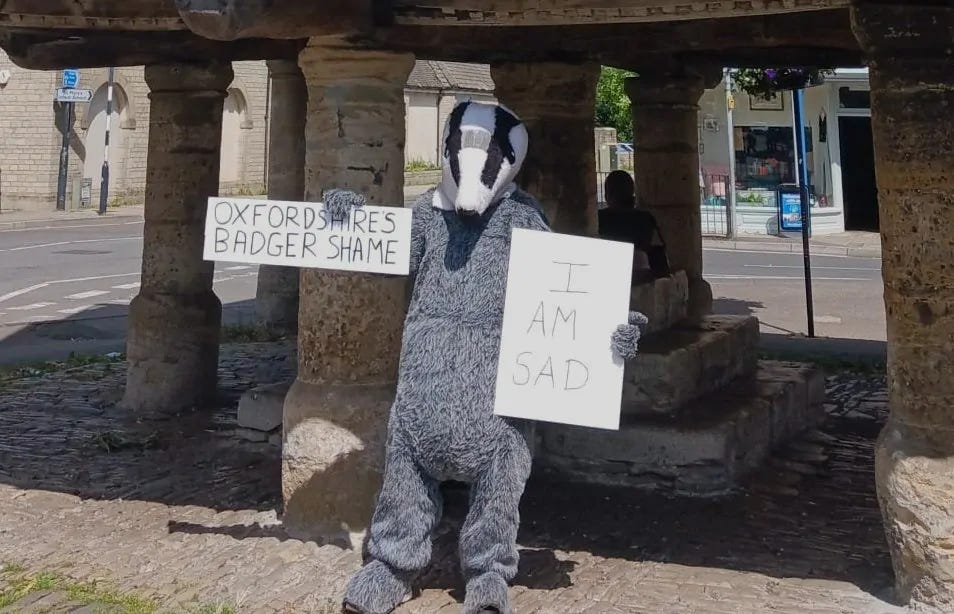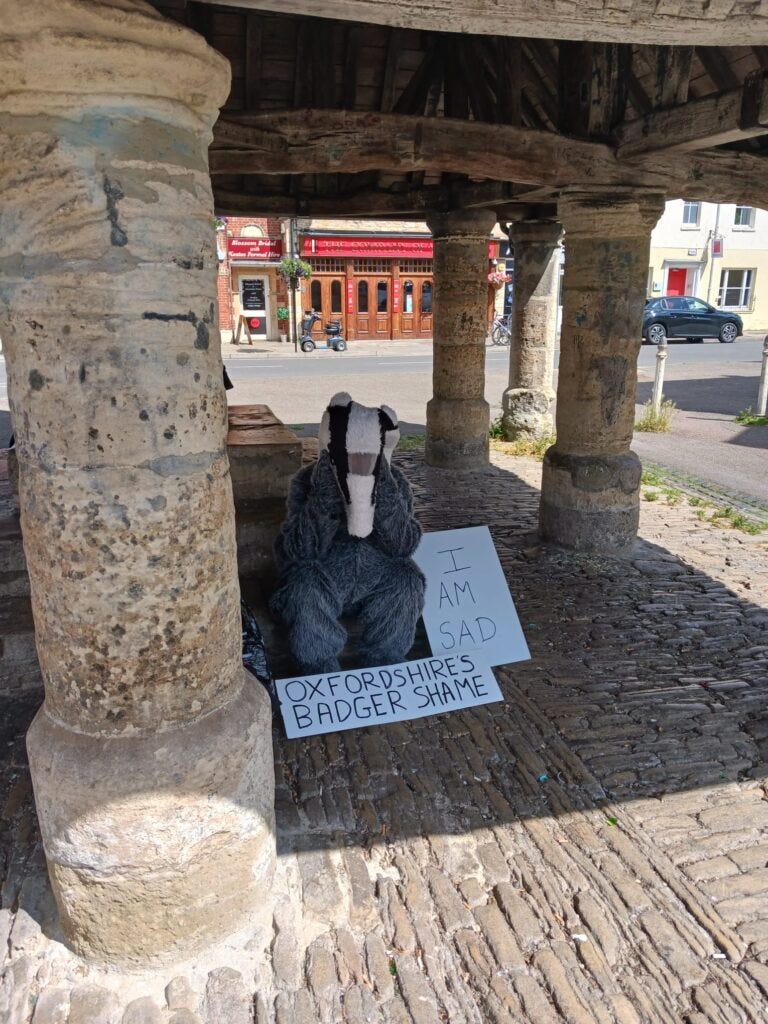Oxford: 'Sad Badger' protests government cull strategy
Badger-suited activist protests in Witney
‘Sad Badger’, an activist from the Oxford Badger Coalition, sat under the Buttercross in Witney’s Market Square on the 17th of July to protest the government’s badger cull with placards saying ‘I am sad’ and ‘Oxfordshire’s badger shame’.
The flawed and highly contested ‘badger cull’ is run by the Department for Environment Food and Rural Affairs (Defra), supposedly to stop the spread of Bovine tuberculosis (bTB) – a disease of cattle. The Coalition, made up of the Oxford Badger Group and a number of pro-badger individuals and organisations including Protect the Wild, is opposed to the mass killing of badgers on behalf of the dairy industry.
The coalition’s focus is on Oxfordshire because a huge area of the county is being targeted and conservationists fear that thousands of badgers will die when the killing starts again in September.
The destruction of badgers began in Oxfordshire in 2020, and in 2022, according to Defra themselves, 1,371 badgers were killed across three cull zones.
As a spokesperson from the Oxford Badger group explained:
“It started with one zone called Area 49 – we do not get told where these areas are. Then in 2021 they added Area 61, a second zone. In 2022 we had a zone three, Area 69.
“We do not know whether there will be another zone added in Oxfordshire this year but they can come back and add new land to the existing areas if landowners want to join the cull.”
Protests
Sad Badger has also staged protests in costume in Oxford and Banbury, and took part in a 50-strong protest outside the House of Commons last week. The activists plan to continue with their protests right through the summer, drawing in audiences and media attention as the movement builds.
They are determined to expose how the badger culls are ineffective, wasteful and cruel, using the most recent scientific findings and a public information campaign.
“We are going to do a pop-up protest once a week until the cull starts in September just to remind people that the cull is still going on. Some people think that it was a one-off.“
A failed policy
A well-researched paper by Dr Mark Jones, Dr Iain McGill, and Tom Langton published in 2022 showed that the government’s own data pointed towards a decline in bTB before the killing of badgers even started and “failed to identify a meaningful effect of badger culling on bTB in English cattle herds”.
Despite this, more than 210,000 badgers have been killed with the permission of Defra since ‘culling’ began in 2013. Few if any were tested for BovineTB after being shot and killed.
The UK badger population is internationally important and the species is supposed to be fully protected by law, yet in 2022 at least 33,627 were killed nationally. Defra aims to kill up to 72% of the badger population by 2025.
The ‘cull’ has been described as “the largest destruction of a protected species in living memory“, a “national wildlife tragedy”, and campaigners have repeatedly warned that the destruction of so many animals will lead to local extinctions.
Will it ever end?
As we reported recently, environment secretary Thérèse Coffey said at the Royal Cornwall Show that she won’t keep to “artificial deadlines” over ending the badger cull.
Before the killing began the UK was said to hold a quarter of all of Europe’s badgers, but rather than a temporary ‘cull’ to control Bovine Tb as the government insisted in 2013, the massacre of one of the UK’s most-loved wild animals really does look now – as campaigners have long feared – to be an ongoing effort to wipe out badgers from huge areas of the countryside.
And if that effort succeeds, bTB will still be a problem for the dairy industry. The farming industry itself acknowledged in May this year that cattle-to-cattle transmission is the ‘most common form’ of bTB spread.
As Sad Badger pointed out this week:
“Bovine TB is a cattle disease which spreads from cattle to cattle. The chances of badgers having it in the first place and passing it to cattle is minimal. The clue is in the name.“





